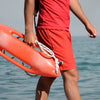Ensuring Safety: A Comprehensive Guide on How to Use a Water Safety Backboard for Aquatic Rescues
In water safety and rescue operations, a water safety backboard is a critical tool designed to safely immobilize and transport individuals with suspected spinal injuries. Let’s delve into a detailed guide on how to effectively utilize a water safety backboard to ensure the well-being and safety of those in need.
Understanding the Water Safety Backboard:
1. Purpose and Design:
• A water safety backboard, also known as a spine board, is a rigid, flat board typically made of plastic or composite material. It serves to stabilize the spine of an individual with a suspected spinal injury during water rescues.
2. Immobilization and Support:
• The primary function of the backboard is to prevent movement of the spine and neck, minimizing the risk of exacerbating potential spinal injuries during transportation.
3. Water-Compatible Material:
• Many water safety backboards are buoyant and water-resistant, specifically designed for aquatic environments and rescue operations in pools, lakes, or beaches.
Step-by-Step Guide on Using a Water Safety Backboard:
1. Assessment and Preparation:
• Assess the victim’s condition and determine the need for spinal immobilization. Ensure the backboard is readily accessible and in good condition.
2. Securing the Victim:
• Collaborate with trained personnel to carefully stabilize the victim’s head and neck before transferring them onto the water safety backboard.
3. Positioning the Backboard:
• Position the backboard beside the victim, ensuring it is aligned straight and parallel to the body, ready for the transfer.
4. Transfer to the Backboard:
• With coordinated effort and caution, gently move the victim onto the backboard while maintaining spinal alignment and stability.
5. Securing the Victim:
• Use securing straps or belts provided with the backboard to firmly but gently immobilize the victim to the board, securing the head and torso.
6. Coordination and Transport:
• Work as a team to lift and transfer the victim onto a stretcher or suitable transportation, ensuring consistent spine alignment and support throughout the process.
7. Professional Care and Monitoring:
• Continue monitoring the victim’s condition, providing reassurance and care until they receive professional medical attention.
Additional Tips:
• Training and Practice: Regular training and practice in using the water safety backboard are essential for swift and effective response during emergency situations.
• Equipment Maintenance: Ensure the backboard is well-maintained, regularly inspected, and stored properly for immediate use in rescue operations.
Conclusion:
The water safety backboard is an essential tool in water rescue scenarios, playing a pivotal role in ensuring the safety and well-being of individuals with suspected spinal injuries. By following these steps and adhering to proper techniques, trained professionals can effectively utilize the backboard to provide secure spinal immobilization and transport during aquatic emergencies.
Through dedication, proficiency, and the use of essential rescue equipment like the water safety backboard, lifeguards and rescue personnel uphold their commitment to swift and safe rescue operations, preserving lives in aquatic environments.
- Posted in Lifeguard Spineboard, Lifeguard Water Backboard

